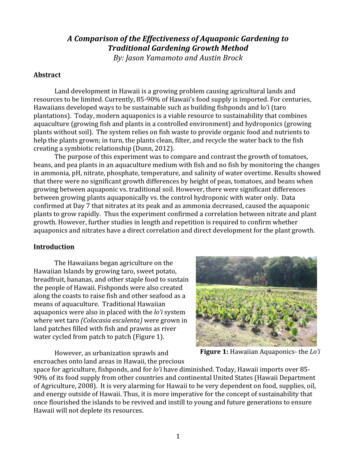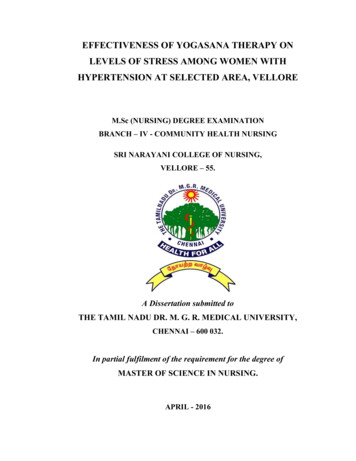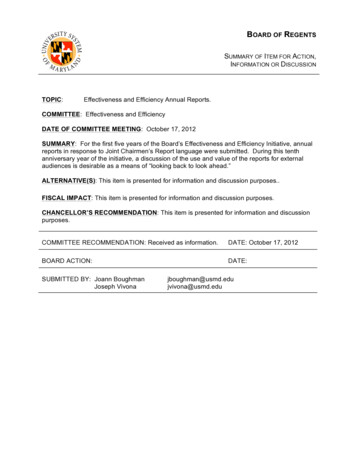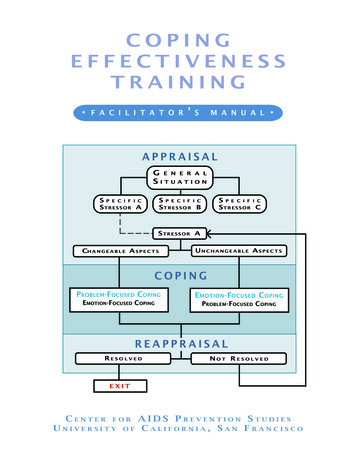
Transcription
A Comparison of the Effectiveness of Aquaponic Gardening toTraditional Gardening Growth MethodBy: Jason Yamamoto and Austin BrockAbstractLand development in Hawaii is a growing problem causing agricultural lands andresources to be limited. Currently, 85‐90% of Hawaii’s food supply is imported. For centuries,Hawaiians developed ways to be sustainable such as building fishponds and lo’i (taroplantations). Today, modern aquaponics is a viable resource to sustainability that combinesaquaculture (growing fish and plants in a controlled environment) and hydroponics (growingplants without soil). The system relies on fish waste to provide organic food and nutrients tohelp the plants grown; in turn, the plants clean, filter, and recycle the water back to the fishcreating a symbiotic relationship (Dunn, 2012).The purpose of this experiment was to compare and contrast the growth of tomatoes,beans, and pea plants in an aquaculture medium with fish and no fish by monitoring the changesin ammonia, pH, nitrate, phosphate, temperature, and salinity of water overtime. Results showedthat there were no significant growth differences by height of peas, tomatoes, and beans whengrowing between aquaponic vs. traditional soil. However, there were significant differencesbetween growing plants aquaponically vs. the control hydroponic with water only. Dataconfirmed at Day 7 that nitrates at its peak and as ammonia decreased, caused the aquaponicplants to grow rapidly. Thus the experiment confirmed a correlation between nitrate and plantgrowth. However, further studies in length and repetition is required to confirm whetheraquaponics and nitrates have a direct correlation and direct development for the plant growth.IntroductionThe Hawaiians began agriculture on theHawaiian Islands by growing taro, sweet potato,breadfruit, bananas, and other staple food to sustainthe people of Hawaii. Fishponds were also createdalong the coasts to raise fish and other seafood as ameans of aquaculture. Traditional Hawaiianaquaponics were also in placed with the lo’i systemwhere wet taro (Colocasia esculenta) were grown inland patches filled with fish and prawns as riverwater cycled from patch to patch (Figure 1).Figure 1: Hawaiian Aquaponics‐ the Lo’iHowever, as urbanization sprawls andencroaches onto land areas in Hawaii, the preciousspace for agriculture, fishponds, and for lo’i have diminished. Today, Hawaii imports over 85‐90% of its food supply from other countries and continental United States (Hawaii Departmentof Agriculture, 2008). It is very alarming for Hawaii to be very dependent on food, supplies, oil,and energy outside of Hawaii. Thus, it is more imperative for the concept of sustainability thatonce flourished the islands to be revived and instill to young and future generations to ensureHawaii will not deplete its resources.1
One alternative solution to sustainabilityis modern aquaponics. Aquaponics technologyhas been recognized in the U.S. since the early1980s. Modern aquaponics combinesaquaculture (growing fish and plants in acontrolled environment) and hydroponics(growing plants without soil). The most commonaquaponic systems employ media‐filled raisedbed, nutrient flow technique for the plantgrowing area integrated with a recirculatingaquaculture tank system (Timmons, Ebeling,Wheaton, Summerfelt, and Vinci, 2002) (Figure2). The system relies on fish waste to provideFigure 2: Modern Aquaponicsorganic food and nutrients to help the plantsgrown; in turn, the plants clean, filter, andrecycle the water back to the fish creating a symbiotic relationship (Dunn, 2012). In addition,pollution, pesticides, and use of chemicals are drastically reduced since only fish waste andfreshwater are used as the growth medium. Most importantly, modern aquaponics uses a smallamount of freshwater and space. So the system can be used in doors, in a green house, back yard,and can be resistant to influxes of natural changes such as temperature, drought, wind, rain,seasonal changes, and other factors if grown in doors. As a result, aquaponics can produce foodin small scale and large commercial scale also (Jones, 2002).During the process of fish respiration, oxygen(O2) and carbon dioxide (CO2) are exchanged, whileammonia (NH3) is released by the fish. To keep the fishhealthy, nitrosomous bacteria convert the ammonia tonitrate (NO3) and nitrite (NO2), which in turn is used bythe plant as the medium for growth (Ochmanski, 2008)(Figure 3). This process is called nitrification.Figure 3: Nitrification Process‐Conversion of Ammonia toNitrate (Jones, 2002).Research showed that nitrification transforms93% to 96% of nitrogenous fish wastes into nitrate(Prinsloo Roets, Theron, Hoffman, and Schoonbee,1999). Un‐ionized ammonia nitrogen at concentrationsas low as 0.02‐0.07 mg/L had shown to slow fish growthand cause tissue damage to fish (Masser, Rakocy, andLosordo, 1999). Since nitrate is the primary source forNitrogen for plants in hydroponic or aquaponic systems,the management of the nitrification process for aquaponicsystems is important for the maintenance of water qualityand the production of nitrate nitrogen.In addition to nitrate, pH is also an important water quality parameter that can affect thenitrifying bacteria in aquaculture biofilters. The pH recommendations for aquaculture systemsrange between 6.5 and 8.5 (Timmons, et. Al, 2002), whereas, the pH tolerances of plants canrange from 5.0 to 7.6 depending on the species (Maynard and Hochmuth, 1997).2
Tilapia (Oreochromis niloticus) and goldfish (Carassius auratus auratus) are the mostcommon fish used in aquaponic systems. Tilapia and goldfish both produce high levels ofammonia, which is good for maintaining nutrient levels for the aquaponic process. Both fish arealso very resilient to changes in pH, pollutants, and temperature (Johanson, 2009). In addition,Tilapia grows quickly, has a good food conversion rate, and can be eaten as well (Childress,2003).Thus, the objective of this experiment was to compare and contrast the growth oftomatoes, beans, and pea plants in an aquaculture medium with fish and no fish by monitoringthe changes in ammonia, pH, nitrate, phosphate, temperature, and salinity of water overtime.Research Question:With the decreasing of farming land and land space, will Aquaponics be an alternative growthmedium for the plants such as tomato (Solanum lycopersicum), bean (Phaseolus vulgaris), and thepea (Pisum sativum) and result in food production?HypothesisIf aquaponics is used to grow tomatoes (Solanum lycopersicum), beans (Phaseolus vulgaris), andpeas (Pisum sativum), then the nitrate converted from fish waste will enhance plant growth inthe aquaponic system.Materials & ProceduresSeedlings and Cups: Prior to starting the experiment, sixty seeds of eachtype‐ tomato, peas, and beans were germinatedunder a 32‐watt Philips fluorescent light for 3 days.About 5 seeds were placed on a petri dish withmoist paper towel on top and on the bottom of thepetri dish to allow the seeds to grow. Thefluorescent light was on for 24 hours for 3 days toallow the seeds to germinate. Each day the seedswere checked and water was added on the papertowel to moisten the seeds. (Figure 4) A total of 72 Gatorade water cups were drilled withFigure 4: Germination of Seedsholes. Four pencil size holes were drilled on thebottom of the cup and 3 rows of 8 holes on the sidesof the cup were also drilled to allow water to drain. The cups were labeled by type of seed and numbered from 1‐8. Specifically, the cups werelabeled from Pea 1‐8, Bean 1‐8, and Tomato 1‐8. A total of 3 sets of cups were labeled ‐one set for traditional growth, one set for hydroponic control with tap water, and one setfor aquaponics with goldfish.3
40 grams of potting soil were added into each cup. Only seeds of tomato, beans, and peasthat germinated and contained roots were planted on top of the soil, and another 20grams of potting soil were placed on top of 3 day germinated seed. The type of seeds usedconsisted of tomato (Solanum lycopersicum), garden beans (Phaseolus vulgaris), and peas(Pisum sativum)100 mL of tap water was added to each cup by using a graduated cylinder to moisten thesoil and seeds and allowed to drainAquaponics and Hydroponic (Control with H20 only) set ‐up 2 Plastic black tub with dimensions 60cmx 85 cm and depth 19 cm were used.(Figure 5) A 4 cm wide hole was drilled in the centerof both black tubs Each hole was plugged with rubber and a20 cm white PVC pipe to act as drainage.An additional 6 cm PVC pipe with holeswas added above the hole so that waterwould drain properly in the tub andprevent rocks from clogging the hole. Two Plastic stands were used to holdaquaponic tub. Two plastic 18 gallon blue tubs wereFigure 5: Plastic tubs, pump, blue rocks,used and filled with 60 L of tap waterPVC pipe, blue tubs for water and fish, and Each plastic blue tub had a water pumptwo standsto recycle water back to tub. Each tub consisted of 1 and ½ bag(60 lbs 27.2 kg each) of blue rocks thatwere thoroughly rinsed and sun dried daysprior to the experiment. The blue rockswere approximately 10 cm in height in thetub and above the water line of the pump. The cups with the germinated seeds wereplaced in order (Peas 1‐8, Beans 1‐8, andTomatoes 1‐8) in the tub so it will be easilyread to take data and held by the blue rocks(Figure 6). Both aquaponic and hydroponicFigure 6: Set‐up of cups in aquaponicexperiments were placed in the same 32and hydroponic experimentwatt Phillips fluorescent light throughoutthe experimentand in the same room temperature. This was also the same light fixture as the traditionalgrowth. The fluorescent light was on 24 hours throughout the experiment. The aquaponic experiment contained 20 goldfish and an Aqueon Quiet Filter PowerFilter 55/75.4
Control Traditional Growth set‐up The germinated seedlings cups were placed in the same 32‐watt Philips fluorescent lightas aquaponic and hydroponic (control water only) and same room temperature ashydroponic and aquaponic experiments. The seedlings were watered with 100 mL of tap water every two days. Note that thewater was drained in the sink before placing the cups back in the light.Height Measurements Each plant growth height was measured every two days with the exception of Day 5 dueto holiday weekend. An average height was taken for each type of plant (tomatoes, bean,and peas) in centimeters. In addition, qualitative observations were also taken for each plant for comparison.Water Quality pH and salinity were measured using Vernier software logger pro probes. Ammonia,phosphate, and nitrate test kits were used. A standard thermometer was used to measuretemperature in CelsiusT‐Tests T test were calculated to ensure significance of data p 0.05. T‐test for average height for bean, peas, and tomatoes for aquaponic vs. hydroponic(control) were compared. T‐test for average height for bean, peas, and tomatoes foraquaponic vs. traditional growth were also compared T‐test for nitrate, pH, salinity, ammonia, phosphate, temperature for aquaponic water andhydroponic control were also compared.5
ResultsTable 1: Average Height of Plants (Tomato 1‐8, Peas 1‐8, & Beans 1‐8) for Aquaponics,Hydroponic‐No fish, and Traditional Growth with Soil.Height Plant with Fish in cmPeas Average HeightBeans Average HeightTomato Average HeightDay 0000Day 2000Day 57.306253.6753.40625Day 714.8759.6556254.0375Day 919.787512.3754.7625Day 1123.987515.268755.39375Day 1328.162517.66256.075Day 1117.662517.66255.575Day 1319.312519.418756.13125Day 1126.187513.5255.2875Day 1339.262514.593756.375T test0.014641030.0007489050.01980695Height Plant with No Fish (Hydroponic) in cmPeas Average HeightBeans Average HeightTomato Average HeightDay 0000Day 2000Day 55.93756.1253.4375Day 710.913.8754.24375Day 915.087515.63755Height of Plant Traditional Growth in cmPeas Average HeightBeans Average HeightTomato Average HeightDay 0000Day 2000Day 59.87.8753.4625Day 717.52511.556254.66256Day 920.537512.71254.85T test0.054484270.401690310.0967402
Figure 8 & 9: Day 13 Results for Growthof Peas, Beans, Tomatoes for all threegrowth mediums (aquaponic, hydroponic,& traditional).Figure 7: Experiment Set‐up Day 0Graph 1: Traditional Growth wasmuch more successful in overallgrowth height for Peas than bothaquaponic and hydroponic, butT‐test does not confirm the growthwith result 0.05448. However,aquaponic had an overall healthierappearance, vibrancy in color, andmuch more effective in growththan hydroponic medium withT‐test 0.01464103 confirminggrowth.7
Graph 2: Hydroponic wasmore successful in overallgrowth height for Beans thanboth aquaponic and traditionalgrowth with T‐test 0.000748905 confirming thegrowth. However, aquaponichad an overall healthierappearance and vibrancy incolor.Graph 3: Based on the graph,there is no significantdifference in growth based onall three mediums. However,T‐test confirmed that therewas a difference growthbetween aquaponic vs.hydroponic with T‐test 0.01980695.8
Table 2: A comparison of Water Quality of Aquaponic growth medium with goldfish vs. no fishWith Fish‐ Water QualityDay 0pHDay 2Day 5Day 7Day 9Day 11Day 13T test7.277.077.517.797.817.577.750.091500196Nitrate mg/L35102010550.004672502Ammonia mg/L00.40.40.20.20.20.20.002329607Salinity ppm0.10.10.10.10.10.10.1#DIV/0!Phosphate mg/L0.50.5216220.462428412Temperature C242424242524240.177958842Without Fish‐ Water QualityDay 0pHDay 2Day 5Day 7Day 9Day 11Day 137.127.467.77.787.87.757.86Nitrate mg/L0000000Ammonia mg/L00000000.10.10.10.10.10.10.1Phosphate mg/L111130.250.1Temperature C24242424242424Salinity ppmGraph 4: Aquaponic medium showed adramatic increase and decrease ofnitrate, where T‐test confirmed thischange at 0.000467. The increase ofnitrate was due to the conversion ofammonia to nitrate by bacteria and thedecrease of nitrate display’s the plant’sconsumption of nitrate.Graph 5: Aquaponic mediumshowed changes in Ammonia due toincrease of fish waste. T‐testconfirmed this change at 0.00232.Ammonia was converted to nitrateby bacteria.9
Discussion and ConclusionIn the experiment to explore the growth of aquaponics compared to traditional gardeningand hydroponic gardening, the quantitative data that was taken showed a correlation betweenmeasurements of plant height and water quality. Observations found that the traditional andhydroponic gardening grew an exceeding rate more than the aquaponics.In Graph 1, traditional gardening showed a higher growth rate of the peas(Pisum sativum) with a difference of 11 centimeters between aquaponic gardening. Althoughgrowing at a faster rate than aquaponic gardening, traditional gardening’s height varied fromDay 2 to Day 11 but then increased rapidly the growth rate from Day 11 to Day 13. Aquaponicpeas grew instead at a steady pace and a constant slope from Day 2 to Day 7 but on Day 7increased rapidly. In addition, aquaponic peas had an overall healthier appearance, vibrancy incolor, and much more effective in growth than hydroponic medium with T‐test 0.01464103confirming the growth.In Graph 2, hydroponic gardening of beans (Phaseolus vulgaris) was much moresuccessful than aquaponic gardening and traditional gardening of with a difference of 2centimeters between hydroponics and aquaponics. Hydroponics beans grew at a constant ratebetween the days of Day 2 to Day 7 but the growth rate lessened after Day 7. Althoughaquaponics growth rate was discrete from Day 2 to Day 7, the growth rate of the beans was muchbetter after Day 7, which correlated to the increase of nitrates (Graph 4) and decrease ofammonia (Graph 5) Day 7. This confirmed that nitrates contributed to the plant growth.In Graph 3, measurements taken for the height of tomatoes (Solanum lycopersicum) fortraditional, hydroponic, and aquaponic had no significance differences in growth. However,aquaponic tomatoes looked much healthier.Thus from this experiment, results confirmed that there was no difference in plant growthbetween traditional, aquaponic, and hydroponic growth of plants. However, it was found thatthere was a correlation of the increase of nitrates with the plant growth in aquaponic medium.Thus, the hypothesis, If aquaponics were used to grow tomatoes (Solanum lycopersicum), beans(Phaseolus vulgaris), and peas (Pisum sativum), then the nitrate converted from fish waste willenhance plant growth in the aquaponic system was supported as shown on Day 7 from Graphs1‐5. Overall, growing plants in an aquaponic medium does show success in plant growth,healthier appearance, and a viable alternative to growing food (Figure 8 & 9).Future ResearchFuture research suggestions include for the experiment to be continued and held for alonger time to observe the changes in growth and rate. In addition, the amount of nitrates shouldbe further researched by setting up different amount of fish in each aquaponic system to see ifthe amount of ammonia waste by the fish, has a direct relationship to the amount of nitratesproduced and growth of the plants.With the knowledge gained and abundance of data gained, it is the hope that with the lossof the land on Oahu, the aquaponic gardening will be successful in growing produce and promotehealthy living.10
ReferencesChildress, Vincent W. "Promising Alternatives in Agri‐technology: Aquaponics." Resources inTechnology. Copyright 2002 EBSCO Publishing, Dec.‐Jan. 2003. Web. 24 Jan. 2013.Dunn, Paul. “An Aquaponics Experiment: Where Tilapia and Tomatoes can be best Buddies.”Times‐News, The (Twin Falls, ID) 12 Dec. 2012: Newspaper Source Plus. Web 24‐Jan. 2013.Johanson, Erik K. “Aquaponics and Hydroponics on Budget.” Tech Directions 69.2 (2009): 21‐23ERIC. Web 24. Jan 2013.Jones, Scott. "Evolution of Aquaponics." Aquaponic Journal 1.1 (2002): 14‐17. Academic SearchPremier. Web. 24 Jan. 2013.Hawaii Department of Education. Food Self‐Sufficiency in Hawai'i. Rep. Honolulu: HawaiiDepartment of Agriculture, 2008Masser, M.P.J Rakocy and T.M. Losordo. 1999. Recirculating aquaculture tank productionsystems: management of recirculating systems. Southern Regional Aquaculture CenterPublication No. 452: 11 pgs. Southern Regional Aquaculture Center: Stoneville,Mississippi.Maynard, D. N. and G. J. Hochmuth. 1997. Knotts handbook for vegetable growers, 4th ed. JohnWiley and Sons, Inc., New York.Ochmanski, Lorianne. "Aquaponics and the Fish‐Lettuce Feedback Loop." Plexus Encyclopedia ofMedicine, Science, and Technology. NewsBank ScienceSource Collection. NewsBank ScienceSource Collection, n.d. Web. 10 Jan. 2013.Prinsloo, J.F. W Roets, J. Theron, L.C. Hoffman, and H.J. Schoonbee. 1999. Changes I some waterquality conditions in recycling water using three types of biofiltration systems during theproduction of the sharptooth catfish Clarias gariepinus (Burchell). Part 1. Relativeefficiency in the breakdown of nitrogenous wastes by the different biofiltration units.Water SA 25(2): 239‐252.Timmons, M. B., J. M. Ebeling, F. W. Wheaton, S. T. Sumerfelt, and B. J. Vinci. 2002. Recirculatingaquaculture systems, 2nd Edition. Northeastern Aquaculture Center Publ. No. 01‐002.Cayuga Aqua Ventures11
A Comparison of the Effectiveness of Aquaponic Gardening to Traditional Gardening Growth Method By: Jason Yamamoto and Austin Brock Abstract Land development in Hawaii is a growing proble










